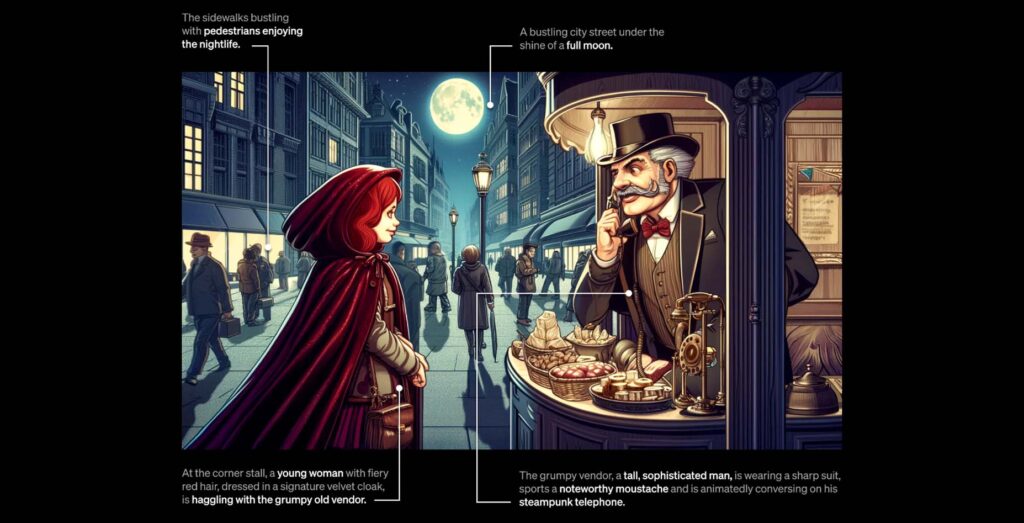Introduction
DALL-E 2 vs DALL-E 3. DALL-E technology has revolutionized the field of AI, enabling the generation of astonishingly realistic images from textual descriptions. As advancements continue to unfold, it becomes crucial to compare the different versions of DALL-E to appreciate their unique features and capabilities fully. In this article, we will explore the distinctions between DALL-E 2 and DALL-E 3, delving into their image generation abilities, linguistic advancements, integration potentials, and more.
Understanding DALL-E 2

Introduction to DALL-E 2
DALL-E 2 represents an evolution in the DALL-E series, building upon its predecessor’s foundation to achieve new heights in image synthesis. With enhanced algorithms and more robust capabilities, DALL-E 2 pushes the boundaries of image generation.
Explanation of DALL-E 2 features and advancements
-
Enhanced image generation capabilities
DALL-E 2 exhibits significant improvements in image generation, resulting in even more lifelike and detailed visuals. Leveraging sophisticated deep learning techniques, it produces images that are nearly indistinguishable from real photographs.
-
Increased resolution and image quality
With higher resolution outputs, DALL-E 2 produces images filled with intricate details and sharpness. The enhanced image quality ensures an immersive visual experience for users and widens the range of potential applications.
-
Improved fine-grained control over generated images
Fine-grained control empowers users to have precise influence over the generated images. DALL-E 2 allows for easy manipulation of various attributes, including colour palettes, lighting conditions, and object orientations, resulting in more personalized and tailored outputs.
Exploring DALL-E 3

Introduction to DALL-E 3
DALL-E 3 emerges as the next notable iteration in the DALL-E series, introducing advancements that push the boundaries of image synthesis and linguistic capabilities.
Description of key enhancements and updates
-
Expanded vocabulary and linguistic capabilities
DALL-E 3 expands its vocabulary and linguistic understanding, allowing it to better comprehend and generate images from complex textual prompts. The model displays an impressive grasp of nuanced language, making it capable of producing visuals that align more closely with the desired concepts.
-
Adaptive image manipulation
Leveraging advanced adaptive image manipulation techniques, DALL-E 3 can dynamically adjust the visual attributes of the generated images based on the provided prompts. This adaptive capability ensures a more accurate translation of textual instructions into the image outputs.
-
Integration with other AI models
DALL-E 3 seamlessly integrates with other AI models, creating opportunities for synergy in diverse tasks. The compatibility and interoperability of DALL-E 3 with various artificial intelligence frameworks enable a collaborative approach to problem-solving and opens doors to new possibilities.
Comparison of Image Generation
A. Image quality in DALL-E 2
DALL-E 2 sets a new benchmark for image quality in the DALL-E series. The algorithm’s improvements result in highly realistic images, exhibiting a level of detail and authenticity that approaches the realm of true photographic representations. Users can expect stunningly vivid visuals that surpass the capabilities of previous versions.
B. Image quality in DALL-E 3
DALL-E 3 takes image quality to another level, building upon the advancements of its predecessor. The generated images possess astonishing clarity, retaining intricate details even in complex and challenging scenes. The increased fidelity fuels an immersive visual experience like never before.
C. Comparing resolution and level of detail
While DALL-E 2 provides impressive resolution and detail, DALL-E 3 elevates the playing field further by generating images with enhanced clarity, enabling users to examine objects at a micro-level. This heightened resolution paves the way for applications requiring pixel-perfect representation and intricate observations.
Analysing Linguistic Capabilities
A. Linguistic richness in DALL-E 2
DALL-E 2 demonstrates a commendable level of linguistic richness, understanding textual prompts and transforming them into meaningful images with remarkable accuracy. The model’s ability to capture abstract concepts and translate them into visual compositions contributes to its versatility and widespread applicability.
B. Linguistic advancements in DALL-E 3
DALL-E 3 builds upon the linguistic capabilities of DALL-E 2, making significant advancements in comprehending intricate language nuances. The model’s enhanced linguistic understanding facilitates the generation of images that more closely align with the intended concept, fostering better communication and creative expression.
C. Evaluating language understanding and generation skills
Both DALL-E 2 and DALL-E 3 excel at understanding and generating images based on textual descriptions. However, DALL-E 3’s improved linguistic skills result in higher accuracy and a greater ability to capture subtle contextual cues. This improvement significantly refines the image generation process and strengthens the connection between language and visuals.
Advanced Image Manipulation
A. Image manipulation capabilities of DALL-E 2
DALL-E 2 presents users with powerful image manipulation capabilities, allowing them to control various attributes and aspects of the generated visuals. The fine-grained control facilitates customization, enabling users to tailor the images to their specific requirements.
B. New possibilities with DALL-E 3

DALL-E 3 widens the realm of possibilities for image manipulation. Its adaptive image generation techniques enable dynamic adjustments based on textual prompts, ensuring that the generated visuals align more closely with the desired outcome. This adaptability empowers users to create images that precisely match their vision.
C. Examining adaptive image generation based on prompts
Both DALL-E 2 and DALL-E 3 facilitate image generation based on textual prompts, with DALL-E 3 showcasing improved adaptability. The model’s ability to modify image attributes in response to text inputs offers a higher degree of control and fidelity, resulting in more accurate translations from words to visuals.
Integration with AI Models
A. Integration potential of DALL-E 2
DALL-E 2 features integration capabilities that enable collaboration with other AI models, promoting synergy and expanding the range of applications and possibilities. By combining the strengths of different models, DALL-E 2 contributes to a more comprehensive AI ecosystem.
B. Expanding connections with DALL-E 3
DALL-E 3 further amplifies the integration potential by seamlessly linking with various AI models. This expanded connectivity enhances the prospects of collaborative problem-solving and enables the utilization of multiple AI models in synergy to tackle complex tasks effectively.
C. Implications of linked AI models for diverse tasks
The integration potential of both DALL-E 2 and DALL-E 3 opens up exciting avenues for diverse tasks that require the combined expertise of multiple AI models. From creative endeavors to scientific research, the ability to leverage complementary strengths can lead to breakthroughs and advancements in various fields.
Applications and Use Cases
A. Popular applications of DALL-E 2
DALL-E 2 has found remarkable applications across various industries and domains. From graphic design and marketing to virtual reality and entertainment, the model’s capabilities have empowered professionals to create compelling visuals that captivate audiences and drive innovation.
B. Novel applications empowered by DALL-E 3
DALL-E 3 expands the scope of applications by introducing new possibilities. Its linguistic advancements and adaptive image manipulation capabilities unlock novel use cases for content creation, branding, educational materials, and even fields such as architecture and product design.
C. Real-world examples of utilization in various fields
DALL-E technology has ventured into diverse fields, leaving its mark on industries like fashion, automotive design, and advertising. With both DALL-E 2 and DALL-E 3, professionals can unleash their creativity and explore uncharted territories, forging new frontiers in visual communication.
Ethical Considerations
A. Understanding ethical implications in DALL-E technology
The advancement of DALL-E technology raises important ethical considerations. It is crucial to understand and address potential biases, privacy concerns, and societal implications to ensure responsible and fair usage of the technology.
B. Addressing potential biases and responsible use
Bias detection and mitigation techniques are fundamental components in ensuring the responsible use of DALL-E technology. Vigilance in monitoring, transparent reporting, and an ongoing commitment to address biases and inaccuracies are essential for mitigating the potential ethical pitfalls.
C. Ensuring transparency and accountability
Transparency and accountability are vital in the development and deployment of DALL-E technology. By fostering an environment of openness, involving diverse perspectives, and establishing clear guidelines and standards, transparency can be maintained, and ethical concerns can be effectively addressed.
User Experience and Interface Improvements
A. UX enhancements in DALL-E 2
DALL-E 2 offers an enhanced user experience with intuitive interfaces and features that streamline the image generation process. The user interface is designed for ease of use, empowering users to interact with the model effortlessly and achieve their desired visual outcomes.
B. User-friendly updates in DALL-E 3
DALL-E 3 builds upon the user-friendly interface of DALL-E 2, introducing updates that further improve the usability and accessibility of the system. These updates ensure that even newcomers and non-experts can navigate the model effectively and generate desired images conveniently.
C. Evaluating accessibility and ease of use
Both DALL-E 2 and DALL-E 3 prioritize accessibility and ease of use, allowing users of varying technical expertise to engage with the models comfortably. The intuitive interfaces, accompanied by clear documentation and guidelines, contribute to a user-centric experience.
Integration Challenges and Technical Constraints
A. Technical limitations in DALL-E 2
DALL-E 2, like any technology, comes with certain technical limitations. These constraints can include processing time, memory requirements, and compatibility with specific hardware configurations. Understanding these limitations helps developers and researchers optimize their workflow while considering trade-offs.
B. Overcoming challenges with DALL-E 3 integration
DALL-E 3 builds upon the foundations of DALL-E 2, addressing and resolving several integration challenges. With increased compatibility and enhancements in computational efficiency, DALL-E 3 offers a more seamless integration experience for developers and researchers.
C. Considerations for developers and researchers
Developers and researchers should carefully evaluate the technical constraints and integration challenges when working with DALL-E 2 and DALL-E 3. By considering the unique requirements of their projects, they can choose the most suitable version of the model, optimizing performance and yield impactful results.
Comparative Performance and Feedback
A. Performance feedback for DALL-E 2
DALL-E 2 has received widespread acclaim for its exceptional performance and realistic image generation capabilities. Users have reported outstanding results across various applications, praising the model’s ability to create detailed, high-quality visuals.
B. Early feedback on DALL-E 3 improvements
Initial feedback on DALL-E 3 highlights the impressive advancements and improvements it brings to the table. Users have witnessed enhanced image quality, linguistic accuracy, and adaptive image manipulation, indicating a positive trajectory for the future of the technology.
C. Comparing user experiences and performance reviews
User experiences and performance reviews of both DALL-E 2 and DALL-E 3 resonate with the models’ strengths and advancements. While DALL-E 2 delivers exceptional image quality, DALL-E 3 showcases enhanced linguistic capabilities and adaptability, forging a path towards even more remarkable image synthesis.
The Future of DALL-E Technology
A. Discussion on potential future developments
The evolution of DALL-E technology is set to continue, with future developments anticipated to redefine the field of image synthesis and linguistic understanding. Ongoing research and exploration pave the way for unimaginable advancements, shaping the future of creative AI applications.
B. Speculation on upcoming advancements and iterations
Looking ahead, we can speculate on upcoming advancements and iterations of DALL-E technology. It is conceivable that future versions may showcase even higher resolution outputs, nuanced linguistic comprehension, and ground-breaking integration potentials, enabling unimaginable possibilities.
C. Anticipating the impact of further progress
As further progress is made in DALL-E technology, the impact on various industries and domains will continue to be significant. Effects such as democratized visual communication, enhanced creativity, and optimized problem-solving approaches are poised to reshape the way we interact with AI systems and leverage their capabilities.
Summary
In summary, DALL-E 2 and DALL-E 3 represent remarkable advancements in image synthesis and linguistic understanding. While DALL-E 2 sets a benchmark for image quality and fine-grained control, DALL-E 3 introduces expanded linguistic capabilities and adaptive image manipulation. Both versions offer exciting possibilities for image generation, seamless integration, and immersive user experiences. The advancements in DALL-E technology pave the way for enhanced creativity, ground-breaking applications, and future progress in the field of artificial intelligence.
- Introduction
- Understanding DALL-E 2
- Exploring DALL-E 3
- Comparison of Image Generation
- Analysing Linguistic Capabilities
- Advanced Image Manipulation
- Integration with AI Models
- Applications and Use Cases
- Ethical Considerations
- User Experience and Interface Improvements
- Integration Challenges and Technical Constraints
- Comparative Performance and Feedback
- The Future of DALL-E Technology
- Summary

DALL-E 2 vs DALL-E 3 – What’s the Difference?